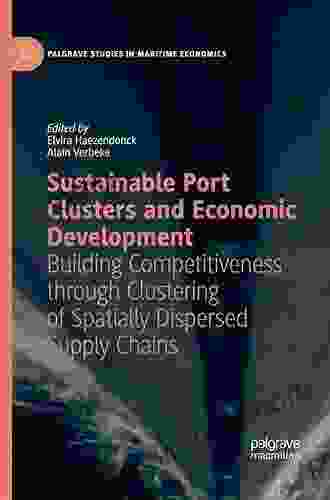Building Competitiveness Through Clustering Of Spatially Dispersed Supply

In today's rapidly evolving global business landscape, organizations are constantly seeking innovative strategies to gain a competitive edge. One such strategy that has garnered increasing attention is clustering, the concentration of interconnected businesses and organizations in specific geographic areas.
Traditionally, clustering has been associated with the geographic proximity of firms within a particular industry or sector. However, recent advancements in technology and logistics have enabled the emergence of spatially dispersed clusters, where organizations are geographically separated yet connected through virtual networks and collaborative relationships.
4.5 out of 5
| Language | : | English |
| File size | : | 8990 KB |
| Text-to-Speech | : | Enabled |
| Enhanced typesetting | : | Enabled |
| Word Wise | : | Enabled |
| Print length | : | 235 pages |
| Screen Reader | : | Supported |
This article delves into the transformative power of clustering in enhancing competitiveness, particularly through the lens of spatially dispersed supply chains. We will explore how this innovative approach can foster innovation, improve efficiency, and drive sustained growth in organizations.
The Power of Clustering
Clustering offers numerous benefits for organizations, including:
- Increased Innovation: Clusters provide a fertile environment for the exchange of ideas, knowledge, and resources, which stimulates innovation and the development of new products and services.
- Enhanced Efficiency: By leveraging shared infrastructure, resources, and knowledge, organizations within clusters can reduce costs, improve productivity, and streamline operations.
- Access to Specialized Labor: Clusters attract and retain specialized talent, providing organizations with access to a wider pool of skilled workers.
- Stronger Brand Recognition: Clusters develop a reputation for excellence in specific industries, which can enhance the brand recognition and credibility of individual organizations.
- Government Support: Clusters often receive government support and incentives, which can further boost their competitiveness.
Spatially Dispersed Clusters: A New Paradigm
While traditional clustering has focused on geographic proximity, spatially dispersed clusters embrace a more flexible approach. This allows organizations to leverage the benefits of clustering while maintaining their existing locations and supply chains.
The emergence of spatially dispersed clusters is driven by several factors, including:
- Advances in Technology: Virtual platforms, cloud computing, and sophisticated communication tools enable organizations to connect and collaborate seamlessly across distances.
- Global Supply Chains: The increasing globalization of supply chains has made it necessary for organizations to establish partnerships with suppliers and customers in different parts of the world.
- Changing Business Models: The rise of e-commerce, outsourcing, and flexible work arrangements has reduced the need for physical proximity.
Benefits of Spatially Dispersed Clusters
Spatially dispersed clusters offer unique advantages for organizations, including:
- Flexibility: Organizations can participate in clusters without relocating or disrupting their existing operations.
- Access to Global Talent: Clusters can connect organizations with specialized talent in different regions, expanding their recruitment options.
- Reduced Costs: By leveraging virtual collaboration tools and shared resources, organizations can reduce overhead costs.
- Improved Supply Chain Efficiency: Spatially dispersed clusters enable organizations to optimize their supply chains by identifying the most efficient suppliers and transportation routes.
- Enhanced Resilience: Dispersing supply chains across different geographic areas can reduce the risk of disruptions and improve overall resilience.
Building Competitive Clusters
To successfully build and leverage spatially dispersed clusters, organizations should consider the following strategies:
- Identify Common Goals: Establish clear goals and objectives for the cluster to ensure alignment among participating organizations.
- Foster Collaboration: Create platforms and opportunities for organizations to connect, share knowledge, and collaborate on projects.
- Develop Shared Resources: Establish shared infrastructure, resources, and training programs to enhance efficiency and reduce costs.
- Attract Talent: Promote the cluster as an attractive destination for specialized talent and provide incentives for recruitment.
- Leverage Technology: Utilize virtual platforms, cloud computing, and other technologies to facilitate collaboration and knowledge sharing across distances.
Clustering of spatially dispersed supply chains presents a powerful strategy for organizations to enhance competitiveness in the 21st century. By embracing this innovative approach, organizations can unlock the benefits of innovation, efficiency, and sustained growth. By fostering collaboration, leveraging technology, and aligning with clear goals, businesses can harness the transformative power of spatially dispersed clusters to drive success in the global marketplace.
In the book "Building Competitiveness Through Clustering Of Spatially Dispersed Supply," we delve deeper into the theory, strategies, and best practices of spatially dispersed clustering. This comprehensive guide provides practical insights for organizations seeking to leverage this transformative approach to gain a competitive advantage.
By embracing the power of spatial dispersion, organizations can unlock a world of opportunities for growth, innovation, and lasting success.
4.5 out of 5
| Language | : | English |
| File size | : | 8990 KB |
| Text-to-Speech | : | Enabled |
| Enhanced typesetting | : | Enabled |
| Word Wise | : | Enabled |
| Print length | : | 235 pages |
| Screen Reader | : | Supported |
Do you want to contribute by writing guest posts on this blog?
Please contact us and send us a resume of previous articles that you have written.
 Book
Book Novel
Novel Page
Page Chapter
Chapter Text
Text Story
Story Genre
Genre Reader
Reader Library
Library Paperback
Paperback E-book
E-book Magazine
Magazine Newspaper
Newspaper Paragraph
Paragraph Sentence
Sentence Bookmark
Bookmark Shelf
Shelf Glossary
Glossary Bibliography
Bibliography Foreword
Foreword Preface
Preface Synopsis
Synopsis Annotation
Annotation Footnote
Footnote Manuscript
Manuscript Scroll
Scroll Codex
Codex Tome
Tome Bestseller
Bestseller Classics
Classics Library card
Library card Narrative
Narrative Biography
Biography Autobiography
Autobiography Memoir
Memoir Reference
Reference Encyclopedia
Encyclopedia George Mentz
George Mentz Colm T Whelan
Colm T Whelan Clarissa Pattern
Clarissa Pattern Cole Coonce
Cole Coonce Randy Hynes
Randy Hynes Coleen Paratore
Coleen Paratore Cleo Lampos
Cleo Lampos David Spiller
David Spiller Curtis T Mcmullen
Curtis T Mcmullen Christopher J Ryan
Christopher J Ryan Euripides
Euripides M Thomas Inge
M Thomas Inge Coleen Bedrosian
Coleen Bedrosian Cynthia Kumanchik
Cynthia Kumanchik Claudia Menini
Claudia Menini K Robicheau
K Robicheau Justin Morgan
Justin Morgan Umran Nayani
Umran Nayani Coral Isabella Aurora
Coral Isabella Aurora Colin Ward
Colin Ward
Light bulbAdvertise smarter! Our strategic ad space ensures maximum exposure. Reserve your spot today!
 Edward ReedFollow ·13.9k
Edward ReedFollow ·13.9k Cormac McCarthyFollow ·4.2k
Cormac McCarthyFollow ·4.2k Bill GrantFollow ·14.7k
Bill GrantFollow ·14.7k Jamal BlairFollow ·2.8k
Jamal BlairFollow ·2.8k Christopher WoodsFollow ·9.2k
Christopher WoodsFollow ·9.2k Gage HayesFollow ·14.2k
Gage HayesFollow ·14.2k Dwight BlairFollow ·12.8k
Dwight BlairFollow ·12.8k Fernando PessoaFollow ·18.2k
Fernando PessoaFollow ·18.2k

 Howard Blair
Howard BlairThe Bewitching of Camille: A Mystical Tapestry of...
Prepare to be...

 Kirk Hayes
Kirk HayesUnraveling the Enigmatic Tale of "Vanished But Still...
In the labyrinth of memory...

 Joe Simmons
Joe SimmonsDogwild: An Unforgettable Literary Odyssey into the Heart...
Delve into the Untamed...

 Edgar Allan Poe
Edgar Allan PoeIndulge in Culinary Delights: Your Ultimate Costa Brava...
Discover the Flavors of Spain's Coastal...
4.5 out of 5
| Language | : | English |
| File size | : | 8990 KB |
| Text-to-Speech | : | Enabled |
| Enhanced typesetting | : | Enabled |
| Word Wise | : | Enabled |
| Print length | : | 235 pages |
| Screen Reader | : | Supported |
















